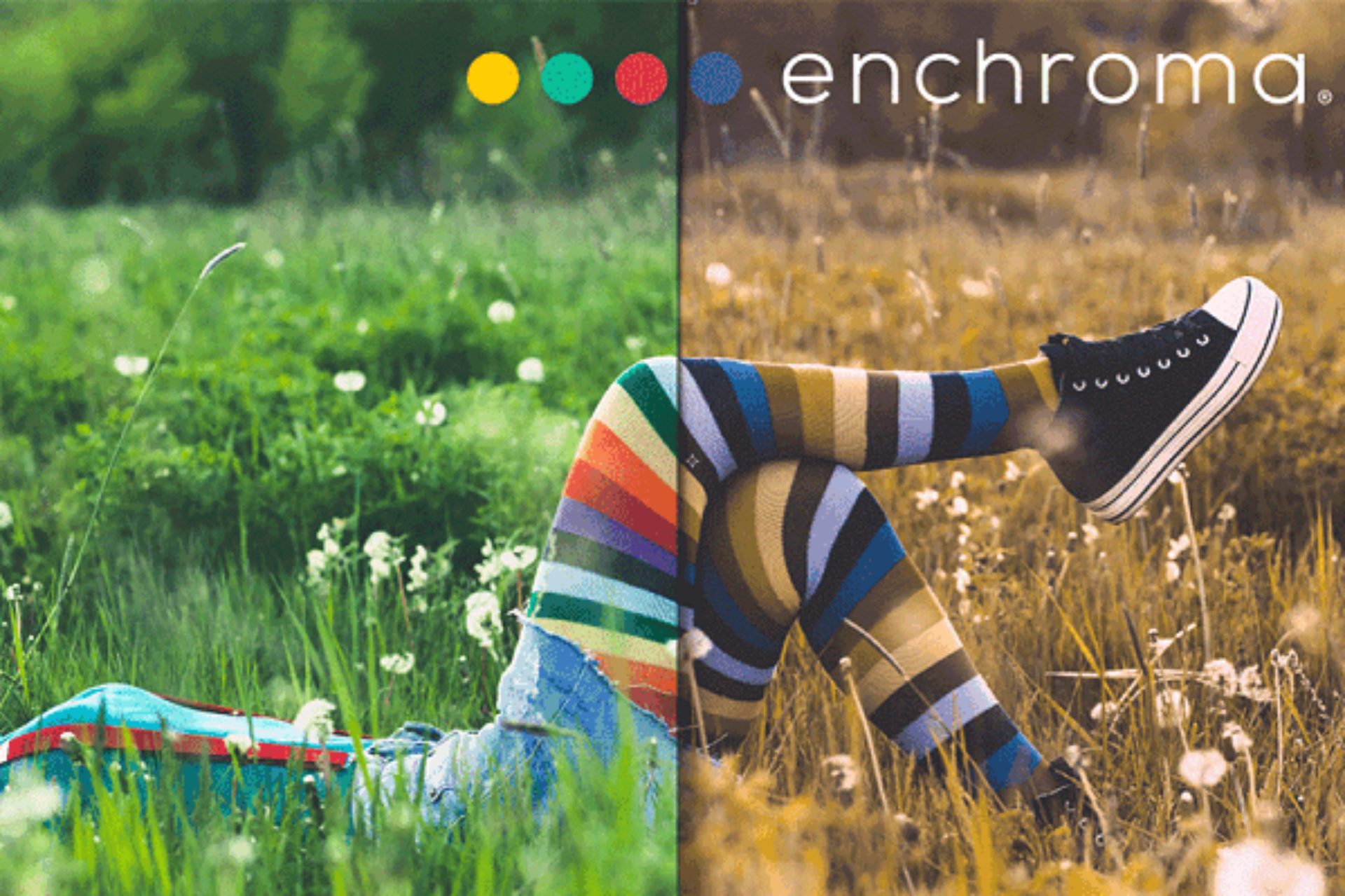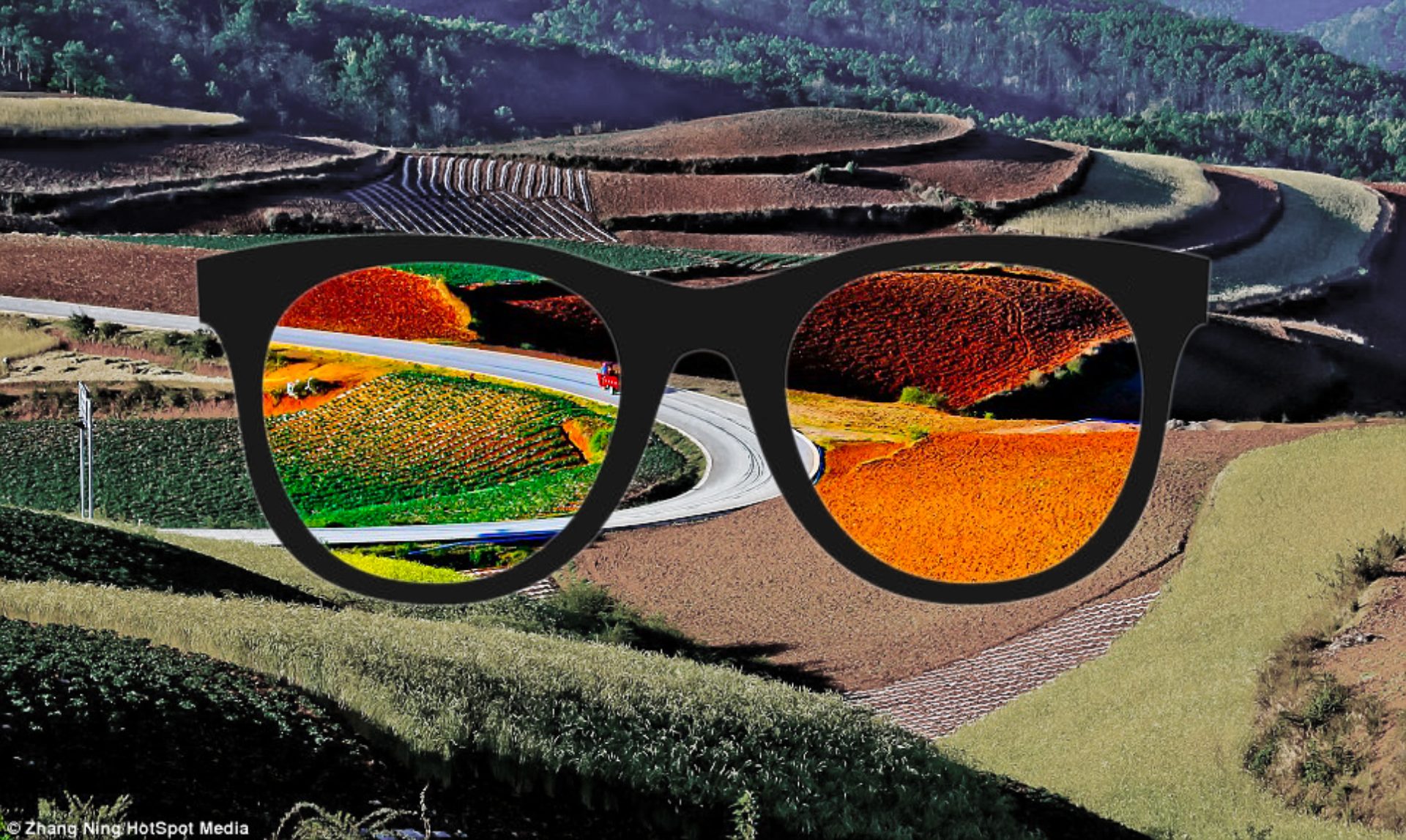
Michaela Bruns, Ayumu Nakajima, Margot Klein
Transcript:
Carolyn Hadlock:
Today we are talking with Don McPherson. He is the inventor of EnChroma, which is a technology that has helped color-blind people see for the first time in color. And I am here with two students because this is part of the BTP course IU edition. Don, welcome to the show.
Don McPherson:
Thank you. Glad to be here.
Carolyn Hadlock:
Let’s start with you have had a very cross-pollinated journey of education. Could you just walk us through what your educational journey was?
Don McPherson:
Okay, sure. I went to Ohio University in Athens, and got a multidisciplinary degree, what’s called a Bachelor of General Studies. I focus on mathematics and art and astronomy, although technically my degree is in math, art, and chemistry. But I was very interested in a lot of disparate, seemingly odd things like linguistics and spider biology and plants and mushrooms and just everything across the board. I would sign up for classes that were most likely above my pay grade, but I was able to successfully talk the professors into letting me take the classes. And then after a few years of that, I realized...I don’t have a degree.
Carolyn Hadlock:
So, these guys understand that I’m sure all too well.
Don McPherson:
Yeah. And so, this English professor Edgar Wan, who was like kind of my mentor, said just get a general studies degree. So that’s what I did.
Carolyn Hadlock:
And then after that you went on to get your MFA.
Don McPherson:
No, actually, that’s a funny question because I was planning to get an MFA. In fact, I drove my car from Ohio, where I lived, to upstate New York. It’s kind of humorous. I was basing this on a completely out of date Barron’s profiles of American colleges. I said that Alfred University had an MFA program in glass sculpture, and I was that was really where I was headed, was to get just become a glass artist. And I went there, and I walked into the glass studio and Fred Cheetah, who was the teacher there, looked at me like I was nuts. He’s like, you drove from Cleveland. We have phones, you know. And anyway, he said, no, we don’t have a MFA program, but you might want to go up and talk to Vern Burdick in the engineering department. So, I sat down and talked with him, and they offered me a scholarship. It’s kind of crazy. So, I ended up getting a master’s in ceramic engineering. And then I stayed on and got my doctorate in glass science.
Carolyn Hadlock:
So ceramic engineering is that exactly?
Don McPherson:
It's basically understanding how inorganic materials behave.
Carolyn Hadlock:
And were you able to delve into sculpture at all or is this more of the technical side of it?
Don McPherson:
No, no, no, no. At that point, I was fully invested in studying science. I kept telling myself that I would get back to it at some point in time. But I had sort of a very wise father who kept telling me you need something to fall back on. You should, you know, continue in engineering and science. And I happen to be reasonably good at it. So, you know, there's a funny thing about science and art. They have a lot of overlap because the people who turn out to have the largest impact in science are either interest, you know, people who just like take something and they just incrementally move along a little bit. And then there's other people who just make these, you know, discoveries that are sort of thinking outside the box. So, I was kind of attracted to the prospect of that and I really loved, ended up really, totally getting invested into the whole theory of glass. What was glass? How is it formed? You know, it's called another state of matter. It's disorganized, which was kind of like I was at that time in my life. So I was, I was drawn to it. And I still love glass.
Carolyn Hadlock:
Have you ever thought about glassblowing?
Don McPherson:
I blew glass my undergraduate. This is what I was studying when I was at Ohio University. I was doing printmaking and glass blowing.
Carolyn Hadlock:
And I, I think you, you raised an important point here with the idea of incremental shifts versus truly inventing things and taking more, you know, wide swings at things. And, you know, at the end of the day, I mean, this is the Beautiful Thinkers podcast, but beautiful thinking really is people who look at things from multiple perspectives, the same problem, the same theme. And that's really what we're here to do with the with the idea of saturated.
Don McPherson:
I did actually. After I post docked in New Zealand, I took a job working at a Japanese optics company for two years. Getting up at 6:00 AM, biking to work every day. You know, you can’t miss a day. You’re doing somebody else’s research ideas. I mean I can do it. So, after two years I decided I wanted to give it my own try. So, I started a glass company in Berkeley and was able to actually explore a lot of the stuff I've been thinking about for years. But you know, you never know really where you're going to get taken. But, you know, there’s some famous saying about, you know, life favors the prepared mind or something to that extent.
Carolyn Hadlock:
Yeah.
Don McPherson:
And I think that preparing your mind, you know, I was watching something the other day, and someone said if you had a time machine you could go back, what would you do? And the person said, oh, I'd probably study harder, which I thought was hilarious.
Carolyn Hadlock:
Yeah.
Don McPherson:
Studying harder? Yeah, okay, I understand that. The inquiry into how things work is really, really one of the most beautiful things that anybody can get invested in. It doesn't matter what the field is, honestly. And I’ve definitely had a lot of luck. I've had a lot of people who... I'm not one of those people who believe that I did it all on my own. I understand there's thousands of people in the in the wings who have helped me get where I am.
Carolyn Hadlock:
Yeah, that totally. I think that's true of everybody who's made it, the people that have helped them along the way.
Margot Klein:
So, the name of the company is very unique and different. Is there origin or background of how you created that name?
Don McPherson:
Actually, that was my business partner at the time, Andy Schmieder who came up with that name and it was just kind of interesting. It's kind of a mix of Latin and Greek or something and it just worked. It's sort of kind of means with color or something like that.

The business name was created by Don’s business partner, Andy, who used a mix of Latin and Greek which means “with color”.
Carolyn Hadlock:
I think the students were very drawn to you because this is another classic invented by accident. Can you just take us through how it came to be?
Don McPherson:
Well, okay. As I mentioned, I started a company making glass and primarily I was working on a lot of different projects. I was getting funding from the National Institutes of Health for various ideas I had for scintillation class glasses to make more efficient mammography scans and things like that. I was all over the map. Infrared fiber optics for laser surgeries, things like that. And one of the things I invented was glasses that would help laser surgeons be able to protect their eyes while doing laser surgery, but with a better perception of what they were doing. The problem with the current laser at the time the state-of-the-art laser safety eyewear were bright orange plastic and the surgeons hated them. They said they gave them headaches; they couldn't differentiate tissue because everything just looked orange. And so, I made some glasses that solved that problem by using what are called rare earth elements in these glasses. And I was able to block the laser wavelength that they're using while at the same time allowing them to differentiate tissue. And I found out through one of the laser medical companies I was selling eyewear to that surgeons were pilfering the eyewear and using them as sunglasses. I thought, oh, that's interesting. So, I started wearing them and I thought, oh wow, these are, these are really good sunglasses because they made certain colors really jump out at you. They really saturated certain colors. And I was at a Ultimate Frisbee tournament in Santa Cruz and one of my teammates borrowed my glasses and I didn't know this, but he was color blind. And he said, dude, I can see the cones. And I started sort of being, you know, scientifically minded. I was like, what are you talking about, Mike? And he said, oh, I without the glasses, the cones look the same color as the grass. And I said, what color is that? He said brown. He said with the glasses on, I can see the glass grass is bright green and the cones are fluorescent. I mean it was like a pretty eye opening, like, what is going on here? So, I started working on that idea and I read up on I knew nothing about color vision deficiency. And I got to the point where I felt comfortable with this, and I cold called a couple of top vision scientists in the country and sort of pitched it to him and they said, yeah, that that might work. So, I submitted a grant to the National Eye Institute, and they funded it, and I did clinical studies at UC Davis and UC Berkeley, and you know had some follow on. We had good results, had some follow-on funding from the National Eye Institute and in 2010 that led to the launching of EnChroma as a company. So, we had a good sound scientific under pending underpinning and I'm based on that we were able to raise some initial seed money.

EnChroma displays images to demonstrate the difference between normal color vision and color blindness.
Carolyn Hadlock:
And did Mike know he was colorblind?
Don McPherson:
Yeah, he knew he was colorblind. He was actually in the first clinical studies and yeah, he knows this. Most people who are colorblind find out in grade school when they miss color things with crayons. People have often called the Crayola crayons. That is the first color blindness test that kids ever have.
Carolyn Hadlock:
Yeah, I could see that. Were there any, any pushbacks or any challenges with the scientific proof?
Don McPherson:
Well, the vision science community was very skeptical and those were the people I wanted most to win over because although I was late into the field and is that is not having training in it, I considered them my peers and so I wanted their approval. Luckily, we ended up with two renowned vision scientists on our science Advisory Board and they were able to help me better understand what was going on with the eyewear and act acted as liaisons to the vision science community so that, you know, there was some explanation coming from their peers which helped a lot. But even to this day, I have some people in the vision science community who still just don't. I don't know what it is, but they just don't like it. And in spite of overwhelming evidence demonstrating that the glasses work at a cortical level, there's still some pushback. But, you know, the whole thing about doing good scientific research is that especially in psychophysics, you try to isolate effects so that there was some pretty good science that was being done. It is a very complicated field because your perception must be constructed from information that you receive from the outside world. And the way in which that happens is, is multi step and there's honestly there's still large areas of the cortical mechanisms that are like Terra Incognito. So yeah, it's a fascinating area of science and I love it. There was a visual artist in England who really loved our glasses. He was colorblind, and he invited a bunch of people to an outdoor gathering. And he had taken a red, red can of spray paint and he'd written the word red on a trimmed hedge that was bright green, right? And he wrote the word red in giant letters. People couldn't see the word red, and they'd put the glasses on. They'd be like, oh my God, says red. It was so cool. And you know, there's this good video of this emergency room worker in Toronto who his friends got into glass, these glasses. And it's just this homemade video of him walking around in the apartment just kind of losing his mind at all the colors. And one point he looks around and he goes, look at the cow man and the camera swivels and it's really this kind of heinous painting of a cow. And it's like modern art and it's all red. It just looks horrible. But for him it was beautiful because he had never seen red in it before. It's an overwhelming emotional experience. And so, for me as somebody with normal color vision, I've been, I've been humbled by a lot of this because I've seen that that this is really life changing for a lot of people. And I try not to take things that I see for granted because of things like that.
Margot Klein:
What do you, what challenges do you think people face with color blindness?
Don McPherson:
Yeah, I mean, there's occupational challenges. You, as you probably know, people who are color deficient, are relegated to certain jobs. They can't do anything to do with the first response. They can't fly airplanes. So yeah, I think that the big, big thing for me is trying to help people who have color deficiency so they can, you know, leave leads a more complete life in the military. There are over 10,000 job descriptions and there's only a handful that you can do if you're color deficient. Something like that would be really beneficial if people could wear glasses and pass color vision tests that would allow them to perform different jobs.
Carolyn Hadlock:
Yeah, that's interesting. And I know that there is a propensity for men to be color blind more than women.
Don McPherson:
So, there's a higher, higher preponderance of men. It's about 8%. It's rare in women. For women, it's around .5%. So that adds up to maybe 350 million people worldwide. One of the things that first attracted me to working trying to address pediatric color blindness is understanding. I read a paper several years ago in which they did a double-blind study, and they found out that when the teachers don't know and the students don't know, students can often be labeled as having learning disabilities. But in actuality, they just can't follow color-coded information very well. And when you only have 11 states testing for color vision deficiency, it gets worse than that. Actually, California tests for color vision deficiency, but they only test boys.
Carolyn Hadlock:
Really.
Don McPherson:
Yeah. And that leaves about 28,000 girls undiagnosed. You think that public schools would want to have that information so they could teach more directed, but there's a lot of resistance to adding in new things like that.
Michaela Bruns:
Would you mind talking a little bit about your color-blind accessibility program that you have it in?
Don McPherson:
That was the brainchild of Kent Streib, who's director of communications. He had this idea that we should get eyewear out and make it accessible to museums, libraries, schools, things like that. In fact, it's been well adapted, well adopted by state and federal park services, many, many universities. We have a lot of interesting ideas we're working with, so I just came back from Washington, DC. I was at a launch of our eyewear at the Smithsonian Museum, which was pretty amazing. You know, they have 38 museums under their umbrella, and they're planning to get the eyewear into all their museums. It was pretty, pretty illuminating to see this group of colorblind people walk around and look at art, and it was interesting. So, the accessibility program has been good because it's a way for us to really expose people to what they've been missing. And surprisingly you think that everyone who would be color blind would know about chroma, but they don't. In fact, our penetration into what you might call the color-blind market is quite small.
Margot Klein:
So, it looks like you've had a lot of accomplishments through the company. Do you know what's next or have any big plans or goals?
Don McPherson:
Absolutely. Absolutely. I've been asked to submit a proposal to the US Army, and I actually met in DC with them when I was there last week. And the other thing that's interesting is the Americans with Disability Act this July finally recognized color blindness as a disability. So, that's huge because we've been wanting that to happen since we were formed. And there's another component of this that you asked what I'm going to, what I'm working on, what the future holds. Okay, so in 2019 there was a clinical study done at UC Davis and what they did was really clever. They created these colored gratings. Now grating is just like something that goes light, dark, light, dark or red, green, red, green. And they had them do a selection, they would show them a reference grading and they had to choose between 2 gratings and say which one is most like it. And from this they were able to construct response curves to increase contrast to color. And they said okay, here's normal people and here's the color deficient look, it's about 40% of normal. And then they gave them the glasses and they had them go home, keep a journal, wear the glasses. And they tested them over 2 week period. And this was just unbelievable. What happened was they brought them back in and they tested. They retested them, and they retested them without wearing the glasses. And their scores improved. It started this whole flurry of interest in this. It's been followed up by a couple of other scientists who have demonstrated that there seems to be some sort of change at the cortical level that's conferred by the glasses.

The Color Blind Accessibility program at EnChroma aims to be more accessible for organizations, such as to help people be able to fully participate in visual experiences. This act led to raising awareness for the Americans with Disability Act and recognizing color blindness as a disability on July 2023.
Carolyn Hadlock:
Yeah, that's a fascinating path to take. One of the things that we are trying to discuss is this is this theme of saturation. We have a lot of, you know, media that is coming in. And I think from your perspective it's interesting because our brain tends to process this information on a visual level. I mean do you think that's changing the way we process the world because that we are getting this like over saturation of news events and in a divided society. So, it's part of a question posed to somebody who studies visual science but also just as somebody who's in the world.
Don McPherson:
So, there's a really brilliant, maybe the most brilliant visual scientist, vision scientist today working at the University of Nevada Reno, Mike Webster. Mike Webster basically has this really interesting idea that we look at the world, we sample a scene and I hope I'm getting this right, but basically there's a, a mean value for the scene, right? If you added up all the pixels in a scene, well, it turns out to be more or less gray, and then there are things that stand out in the scene because they are highly saturated. We notice the things in the scene first that are saturated beyond the variance of the mean. So, you can basically think of the world as having a mean and a variance. And we notice the things that are outside the variance. That's what our eye is drawn to. You just look around the room, you can see what I'm talking about. When he first, when I first read this description of his, I was like, that is pretty profound because it doesn't just apply to color, it applies to everything. So, the person who's yelling the loudest gets the attention, the person who's doing something outlandish gets the attention. People who have figured out that if you do something that's like outside the variance, it gets attention. And I think that that's the thing that we all must recognize. Like we can't help it. Our minds are drawn to it, and we should just be careful because it's outside the variance. Yes, we look at it, but we shouldn't like under. We shouldn't let that become the thing that we focus on. But I think that in in the context of certain things, it's probably a good idea to try to find stable, you know, neutral patterns and things and not be so attractive as a thing that's out there.

Mike Webster's data visualizations present subjects' color perception in the greyscale and color conditions.
Carolyn Hadlock:
The last question that we ask everybody that we speak with is this is a podcast that explores beautiful thinking. And we always ask people; how would you define beautiful thinking?
Don McPherson:
That's really interesting because, you know, it's like Occam's razor, right? I saw a talk at the Optical Society of America Fall Vision meeting in Seattle 2 weeks ago, and it was by Andrew Watson, who's the head of vision at Apple. Absolutely fantastic guy. And he mentioned Occam's razor as sort of like the way that a lot of scientist's work, right? It's like, given all the possible solutions, choose the one that's the most, you know that's the most logical and requires the least hand stands and backflips of logic, right? But then he modified it, and he said he thinks that we should also follow Occam's cone, which is choose the solution that is the most beautiful because it will also, you know, have contained within it simplicity.
Carolyn Hadlock:
Thank you so much for listening to this episode. This episode was created and produced at the IU Media School as part of the Beautiful Thinkers Podcast IU Edition. To follow along this season, check out Beautiful Thinkers on Instagram and TikTok. Special thanks to Michaela Bruns, Margot Klein, and Ayumu Nakajima for their research and recording of this episode, as well as thank you to Natalie Ingles for our music.


